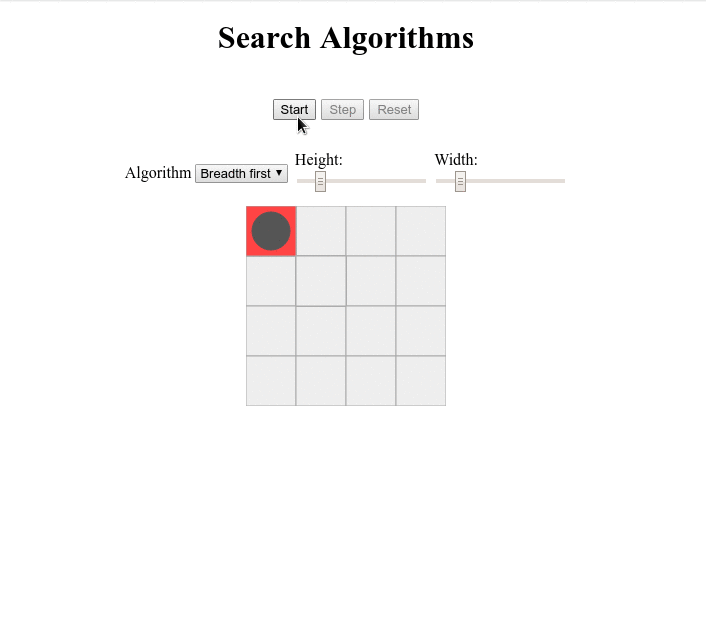SWI-Prolog based tracer for visualisation search algorithms such as depth first, breadth first, best first, A*, ... search
Install dependencies using yarn then run ./serve.sh and visit
http://localhost:4000
Here's a demo of the visualisation:
-
The dark circle indicates the agent, it tracks the path through the search tree.
-
Light blue cells indicate those that have been visited by the algorithm.
-
Dark blue cells indicate those that are on the current path being explored.
-
The width/height of the grid can be adjusted
-
The search algorithm can be toggled through any that are implemented on the server
-
The starting position of the agent can be chosen by dragging the agent to the desired starting cell
-
The goal position can be selected by clicking on a cell.
-
Searches can be aborted using the reset button
Search algorithms are abstractly defined by the prolog record search_strategy. Search strategies define methods for ...
- Combining the current agenda with the agenda items created for the children reachable from the current state
- Computing the cost of an agenda item given
handgpredicates - Depth bounds
The following predicates define a search strategy:
combine_agenda(+OldAgenda:list(agenda_item), +ChildAgenda:list(agenda_item), -NewAgenda:list(agenda_item))combinesOldAgenda, the current agenda (minus the agenda item we popped off) andChildAgenda, agenda items corresponding to the children found bychildren/2defined in thesearch_problem.cost(+G:callable/3, +H:callable/3, +From:state, +CostToCurrent:integer, +To:state, -FCost:f(CostToNode:integer, HeuristicCostToGoal:integer))evaluates the child stateToreachable fromFromusingGandH, predicates defining the cost of moving fromFromtoToand fromToto a goal. Note thatGdiffers from the its traditional definition in the A algorithm literature, instead of computing the cost of a state from scratch it is much easier to compute the cost difference of a single move in the search true keeping a running total along a path.
Search problems are abstractly defined by the prolog record search_problem, there are two example problems:
- grid search
- black-white counter puzzle (see the Simply Logical chapter for an explanation)
Search problems are defined by 5 predicates:
start(-StartState:state), first argument unifies with the starting state of the search problem, e.g. the starting position of the agent in a grid search, or an initial board state in a game tree search.goal(+State:state)holds ifStateis a goal state or not.children(+State:state, -ChildStates:list(state))the reachable child states fromStateh(+State, -Cost:integer), cost unifies with the h-value ofState. The h-value is the heuristic estimate for how must it costs to reach the goal state fromState.g(+State:state, -Cost:integer), cost unifies with the cost of reachingStatefrom the start state as defined bystart/1.
The predicates are wrapped up into a search_problem record using search_problem:make_search_record.
The state type is user defined--the search algorithms are orthogonal to the representation, you can choose your state representation however you see fit.
See DEVELOPMENT.md for technical details.
